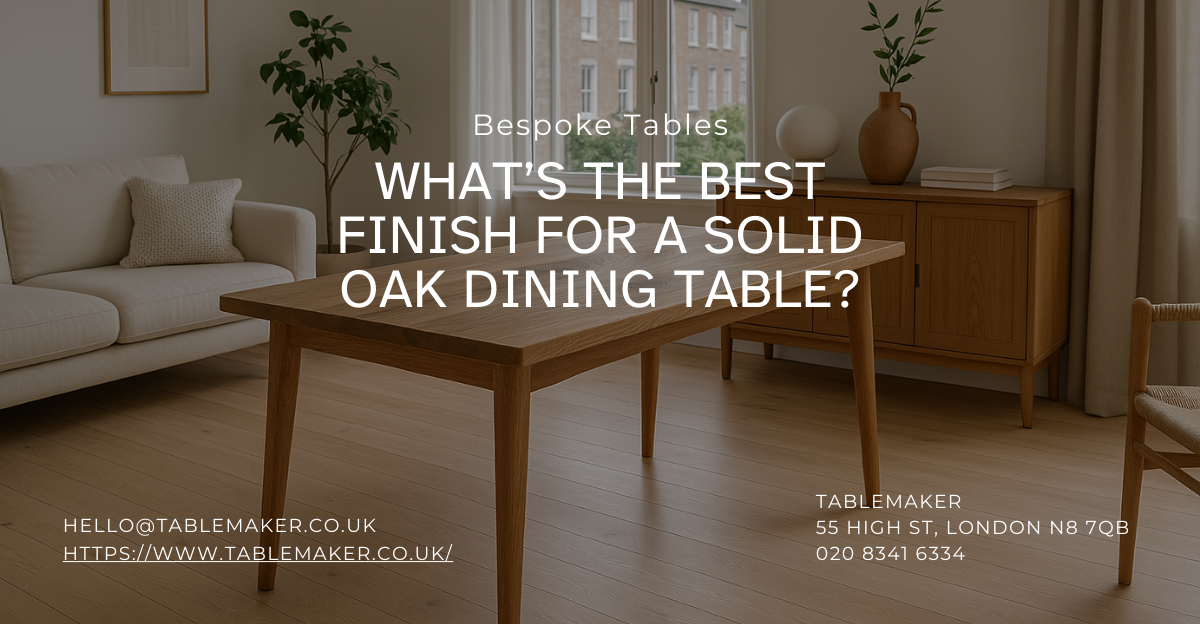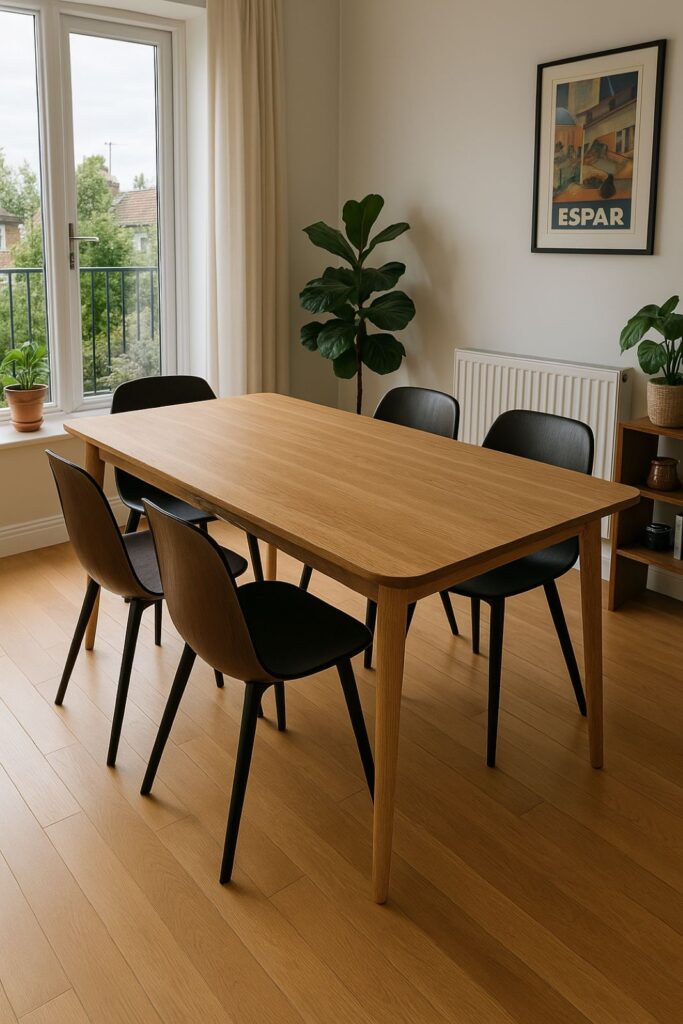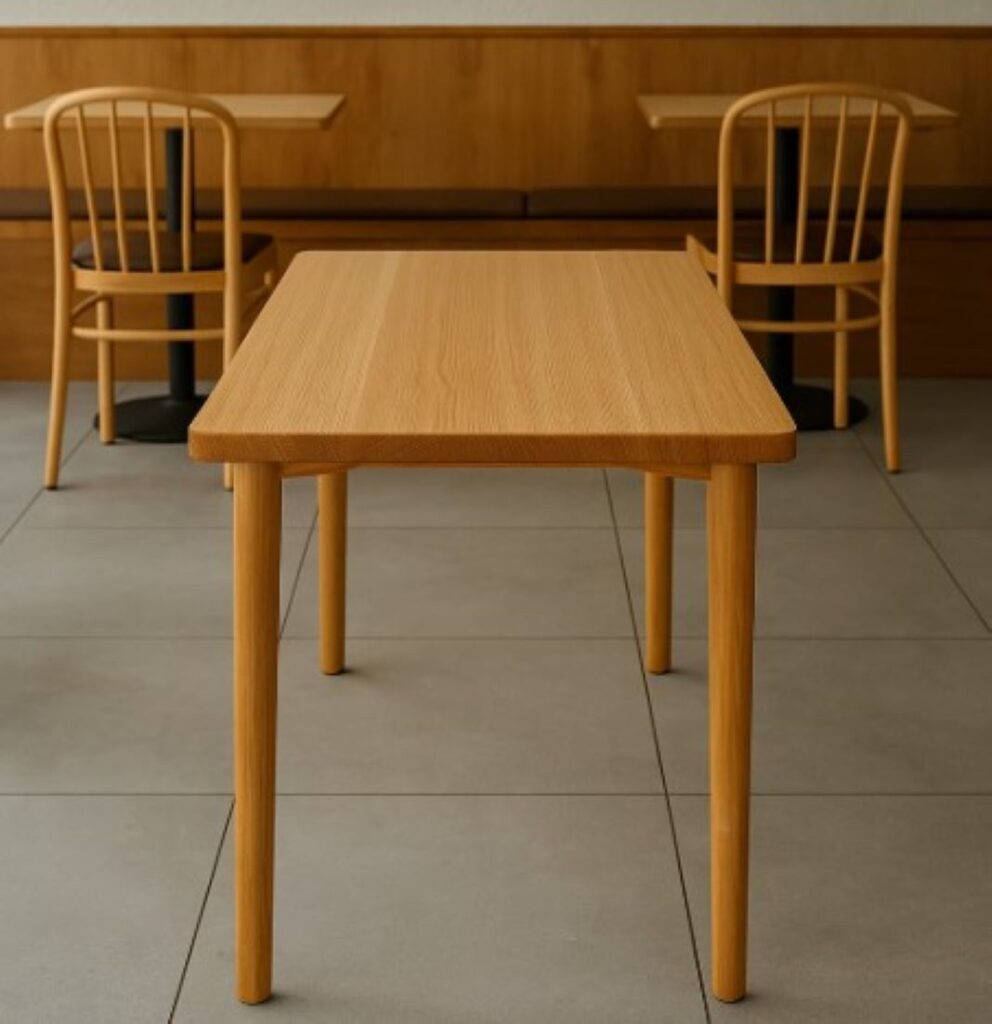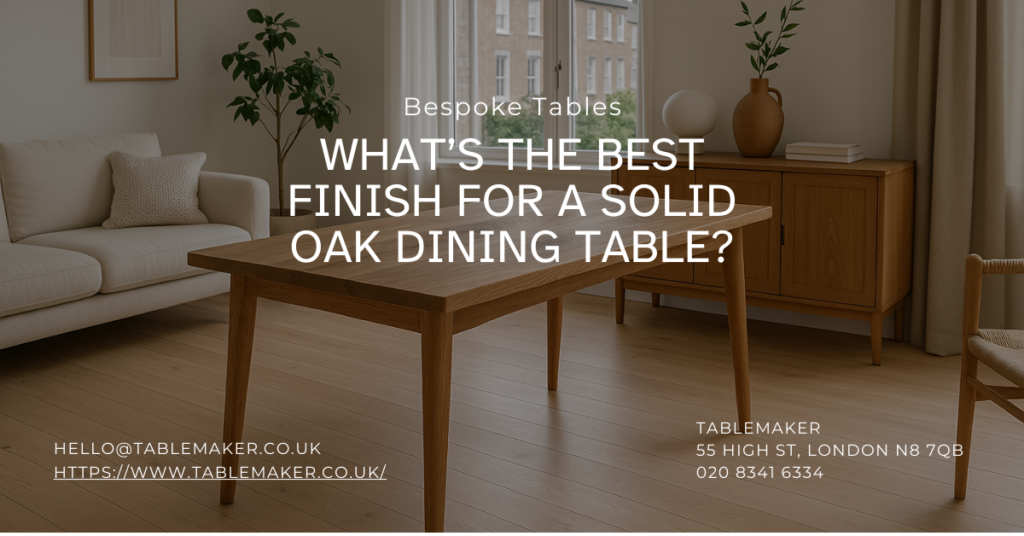
What’s the Best Finish for a Solid Oak Dining Table?
What is the best finish for a solid oak dining table in 2025?
The best finish for a solid oak dining table depends on how the table is used, the desired appearance, and maintenance expectations. For most households in the UK, a hardwax oil such as Osmo Polyx or Rubio Monocoat provides the ideal balance of durability, aesthetics, ease of repair, and food safety. Varnishes, oil blends, and lacquers are also viable, but each has its own strengths and limitations. This guide breaks down every major type of finish, compares them by lifestyle needs, and provides expert advice from Tablemaker London on how to choose the right one.
In this article about solid oak dining table finishes, we have covered
- Why Finish Matters for Solid Oak Dining Tables
- Key Considerations When Choosing a Finish
- Overview of All Major Oak Table Finishes
- What is the best finish for oak tables in homes with children?
- Comparison Table: Finish Types at a Glance
- Tablemaker’s Expert Recommendation
- How to Maintain a Finished Oak Dining Table
- Common Mistakes to Avoid
- Oak Finishing Trends in 2025
- Frequently Asked Questions
- Choose the Right Finish with Confidence
Why Finish Matters for Solid Oak Dining Tables
Understanding Oak’s Natural Beauty and Grain
Solid oak is known for its warm tones and distinctive grain patterns. It is a popular choice for furniture because it is strong and long lasting. A good finish helps bring out the character of the wood while protecting it from daily wear, moisture and heat. European oak and American white oak can behave slightly differently, so it is worth considering how each type responds to oil, wax or varnish.
The Importance of Choosing the Right Finish
Choosing a finish is not only about the appearance when it is new. It affects how the table looks over time, how easy it is to care for, and whether it can be restored easily. Some finishes soak into the timber and maintain a natural feel, while others form a sealed topcoat that is harder and more resilient.
Key Considerations When Choosing a Finish
Durability Against Scratches, Heat, and Spills
The finish plays a large role in protecting the surface from heat rings, stains and surface abrasion. Polyurethane varnish is among the most impact resistant options and is well suited for high traffic areas. Hardwax oils like those from Osmo and Rubio Monocoat offer good resistance to water and wear while preserving the natural texture of oak.
Food Safety and Non-Toxic Options
Dining tables should be finished with food contact safe materials. Hardwax oils that conform to EN 71.3 safety standards are commonly used by furniture professionals. Osmo Top Oil, Fiddes Hard Wax Oil and Rubio Monocoat Oil Plus meet these criteria and are ideal for homes with children or pets.
Maintenance Requirements and Longevity
Hardwax oils are easy to maintain. They allow for local repairs and do not require full sanding before reapplication. Traditional varnishes provide longer intervals between applications but must often be fully stripped and reapplied if damaged.
Appearance: Matte, Satin, or Gloss
Matte finishes offer a raw wood appearance. Satin provides a balance of subtle sheen and ease of cleaning. Gloss finishes reflect more light and can highlight grain details but tend to show scratches more easily. The choice depends on the desired look and how the finish interacts with light in your dining space.
Eco-Friendly and Low-VOC Concerns
Finishes with low volatile organic compound levels are preferable for indoor air quality. Natural oil finishes derived from plant oils and waxes are a sustainable option and produce fewer emissions. For more on indoor-safe wood finishing, see our advice on low-VOC timber treatments.
Pro Tip 1: Always test your chosen finish on an offcut or a hidden part of the table. Oak varies naturally, and even the same product can look slightly different across boards.
Overview of All Major Oak Table Finishes
Oil Finishes: Danish, Tung, Linseed, Walnut, Teak
These penetrate the surface and provide a natural feel. Danish oil is a popular blend that dries faster and hardens better than pure linseed. Tung oil offers a flexible and water resistant barrier. Walnut oil has a softer, slow-drying nature and is sometimes chosen for allergy-sensitive homes. Teak oil is designed for dense timbers and may alter the tone of lighter oaks.
Hardwax Oils: Osmo Polyx, Fiddes, Rubio Monocoat
Hardwax oils combine penetrating oils with surface wax for double protection. They maintain breathability and a tactile finish while resisting household stains. Rubio Monocoat bonds at the molecular level to oak fibres and requires only a single coat. Osmo Polyx is more widely used for its forgiving application and long term protection.
Varnishes: Polyurethane, Water-Based, Acrylic
These form a film over the timber surface. Polyurethane varnishes offer high abrasion and chemical resistance and are suited to commercial or high-use settings. Water based acrylic varnishes maintain a clear finish and resist yellowing, making them ideal for light-coloured oak. These finishes are best applied in multiple thin coats to reduce the risk of cracking.
Lacquers: Solvent-Based and Water-Based
Lacquers dry rapidly and give a consistent finish but can be more brittle over time. They are usually sprayed on and are used in production environments. Modern water based lacquers have improved durability and reduced odour but may require careful ventilation during curing.
Waxes and Oil-Wax Blends
Wax finishes are soft under hand and offer a gentle sheen. On their own they are not very durable and require regular maintenance. Used in combination with penetrating oils, wax can help repel moisture and improve surface feel. Wax is better suited to occasional use furniture or as a decorative topcoat.
Pro Tip 2: Keep a small tin of your chosen oil or wax to hand. Spot repairs on hardwax oil finishes are quick to do and help maintain the table’s appearance year-round.
Custom made solid oak dining tables & finishing services in London and the UK – Tablemaker
What is the best finish for oak tables in homes with children?
For households with children, the finish must be safe, resilient and easy to repair. Hardwax oils are widely recommended by professionals for these settings. Products such as Osmo Polyx Oil and Rubio Monocoat Oil Plus are food safe once cured and allow spot repairs without refinishing the entire table. Their low odour application and non-yellowing finish also make them practical for family environments.
Comparison Table: Finish Types at a Glance
| Finish Type | Appearance | Maintenance | Durability | Food Safe | Notes |
|---|---|---|---|---|---|
| Hardwax Oil | Natural matte | Easy spot repairs | High | Yes | Ideal for family dining tables |
| Polyurethane | Gloss or satin | Requires sanding | Very high | Check label | Tough but harder to repair |
| Water-Based Varnish | Clear/matte | Moderate | Medium-high | Often | Non-yellowing, fast drying |
| Danish Oil | Warm satin | Occasional re-oil | Medium | Sometimes | Traditional option |
| Wax | Soft sheen | Frequent upkeep | Low | Often | Decorative, low protection |
Tablemaker’s Expert Recommendation
We consistently recommend hardwax oils for oak dining tables. Our team applies Osmo Polyx Oil in layers that allow the oak to breathe while offering long lasting protection. It enhances the natural grain without forming a thick surface film. Our customers tell us it keeps their tables looking fresh with minimal effort, even in busy households.
How to Maintain a Finished Oak Dining Table
Daily Cleaning Tips
Use a soft cloth slightly dampened with water. Avoid harsh sprays or ammonia-based cleaners. Dry the surface completely after wiping.
Long-Term Maintenance Schedule
Refresh hardwax oil finishes every 12 to 18 months depending on usage. Sanding is usually unnecessary unless the surface is deeply scratched or stained.
How to Spot Repair Scratches and Stains
Clean the affected area with a damp cloth. Apply a small amount of the same oil used originally. Let it soak for 5 to 10 minutes then buff dry.
When and How to Refinish
If the entire surface becomes dull or patchy, lightly sand with fine grit paper, wipe clean and reapply the original oil. Always follow manufacturer instructions.
Common Mistakes to Avoid
Applying too many coats can cause the surface to remain tacky.
Using incompatible products may lead to peeling or cloudy patches.
Ignoring manufacturer drying times increases the risk of a sticky surface.
Failing to test on a sample piece can result in unexpected colour changes.
Oak Finishing Trends in 2025
Matte and raw wood looks remain popular.
Light pigmented oils are in demand for keeping oak pale and natural.
Plant-based, low-VOC finishes are preferred for eco-conscious homes.
Frequently Asked Questions
Can I refinish my oak table at home?
Yes, if you use oils or hardwax finishes, refreshing the surface is straightforward. Varnished tables may require sanding back fully before refinishing.
How long does a finish last?
Hardwax oils last around 1 to 2 years with regular use. Varnish can last 5 to 10 years if properly applied and cared for.
What finish changes oak the least?
Natural-toned hardwax oils like Osmo Polyx Raw or Rubio Monocoat White 5% preserve the natural colour with minimal darkening.
Which finish is best for everyday dining use?
Hardwax oil provides the best balance of resistance, ease of use and appearance for regular dining.
Can I switch from varnish to oil?
Only after full sanding. Oils must soak into the wood, so any film finish like varnish must be completely removed first.
Choose the Right Finish with Confidence
There is no one-size solution when choosing the best finish for your oak dining table. Whether you prefer natural matte looks or need something highly durable, the options explained above can help you match your lifestyle and interior style. At Tablemaker, we help our clients not only choose the right finish but also apply it properly so it stands the test of time.
Explore our portfolio to see how different finishes look on real oak dining tables or get in touch for friendly, expert advice.
Tablemaker
55 High St, London N8 7QB
02083416334
HVQM+58 London




